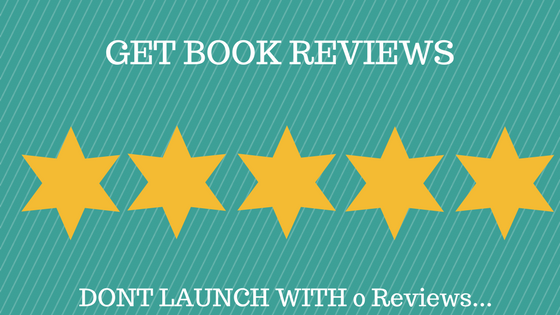I am loathe to show it here, but I will, if you promise not to make too much fun of me. It’s so ugly. I still can’t believe I put it up on Amazon. Yikes!
I quickly added a new one as soon as I came to my senses and realized this one was awful, and paid for one to be done on Fiverr.
For Fiverr this cover actually looks awesome I think. For a first book? I was all for it. Is it the best cover ever? No of course not, but for a book that was comprised completely of old blog posts and quickly compiled into a word doc, it worked for me.
You can see both of those covers below, no need for me to tell you which is which.


Book Marketing Tactic #1: Get a Quality Book Cover

- Reviewers who see your cover are more likely to agree to review your book. It shows them you were invested enough in yourself and the quality of your book that you took the time to have a cover professionally designed.
- If you decide to give your book away for free on a platform like Instafreebie, more people will download your book solely based on your cover.
- Your cover is your first impression marketing tool for your and your book. Do you want to have the face of your publishing business be a cover like the one I shared above?
Please, don’t make the same mistake that I did, follow these steps to hire a book cover designer and never look back.
#2: Pick an Award Winning Title
But how do you do this? How do go from nothing, to a punchy title that will get people to click and buy?
Here are some tips for you to get you started.
Title and Subtitle
Let’s break it down into title and subtitle. Both are equally important, but it can be helpful to view them as separate entities at least in the brainstorming phase.
Title
Finding a good title is key, but it can be hard to come up with it from nothing. Even if you have a solid grasp about what your book is about, nailing down a title can be a trying process.
The best way to start this process is to:
- Look up other books in your genre and see what they are doing. Again, we don’t want to copy anything word for word, but if you can come up with some good ideas using this method go for it. I find that this can be especially helpful if you have no idea what you want to call your book.
- Notice the style of titles of books on Amazon. Most of them have short 3-5 words for the actual title, and then expand in the subtitle with anywhere from 5-15 more words.
- Start writing down every single title that comes to mind for your book. Add this to a document or do a whiteboard brainstorming session. It can be beyond helpful to do a complete “brain dump” and get out all of your ideas. Once they are all out there you can mix and match and ultimately find the best one.
- Don’t worry too much about keywords here, we can add those into the subtitle.
The title will usually not come right away. Don’t force it, and don’t feel like you are spending too much time on it. Remember that the title of the book is one of its three most important aspects, and you would do well to make sure it’s good.
The defining characteristics of a good book title is one that you can tell your friends, that rolls off the tongue, and also doesn’t need a huge explanation.
When you can say yes to those three things, you know you have yourself a winner.
Subtitle
The subtitle can be a little tricky in its own right. Where the title focuses on capturing people’s attention quickly, the subtitle goes into a little bit more detail on what the book is about and what it will do for the reader.
To come up with ideas for a good subtitle:
- Do the same type of browsing through similar Amazon book titles that you did to find a title.
- Utilize KDP Rocket to find good keywords for your book. Keywords are highly important in a good subtitle. While you can and should put good keywords in your book description, they are worth more in the subtitle in terms of Amazon search power.
- Brainstorm a long list of potential subtitles for your book, put them together with your title, and then mix and match to find 3-4 favorites.
- When you find 3-4 favorites share these on your social media channels or blog. This acts as a great way to build buzz for your book, but also helps you to get feedback.
- I would also recommend sharing your titles with a friend or family member and using them as a sounding board for ideas. I did that with every one of my titles and I am glad that I did, as it helped my mind to stay fresh with ideas.
Ultimately your title and subtitle should be something you are happy with. You are the author, and thus you want to be proud of the product you put out there. Keep thinking about it and brainstorming and eventually you will come up with the perfect title.
This process takes time. I also don’t suggest using any type of online title generator because I don’t find them useful.
Stick to the format of the title with 3-5 words, and the subtitle from 5-15 and you will do great.
For more on getting an award winning title for your book see 4 Steps to Choosing Your Book Title.
Get Your Free Guide Here

Looking for a launch plan for your book launch? Grab my new book “Book Launch Gladiator” right here and get a leg up on the marketing aspect of self publishing.
#3: Rock your Book Description
Getting a good book description in place for your book will definitely help to sell your book. Why? This is the chance to tell readers about you and your book and convince them to take a chance on you.
Just envision the sales process for a second. Potential readers have clicked on your book because of your killer title and/or beautiful cover. Anyone that clicks on your book and has made it this far has a very good chance of buying your book.
Amazon customers are ready to buy as proven by Amazon’s ridiculously high 10% conversion rate, and now is your chance to convert.
Here are the four major parts of a great book description:
- What is the book in brief and who is it for? This is the intro to the book description:
- What is the main point? What is the problem that your book is trying to solve? For fiction; what fantasy need will your book fulfill?
- Who is the book for? Who is going to read this? Think target audience.
- Provide an early hook for readers. Grip them into wanting to keep reading to the end.
- About the Book:
- The meat of the description
- What is the solution to the pain point you identified?
- Why you? Why should the reader buy from you?:
- What is your unique story?
- Regardless of what your story is how have you made it unique?
- Why is it better than other similar books in the genre?
- What is your USP (unique selling proposition)?
- What is it about you that puts you in the unique position to sell a book of this nature?
- Have a clear CTA (call to action) at the end:
- Make it clear that you want them to buy your book
- Give them a line that literally says “buy my book now” or come up with something creative
You don’t have to follow this exact process of course, but it’s a good way to get started.
Here is the book description I wrote for my newest book “Book Launch Gladiator: The 4 Phase Approach to Kindle Book Marketing Success in 2018”
“This book is perfect for anyone who loves actionable content without a lot of fluff. ~ Steve Scott, Wall Street Journal bestselling author.
Are you Struggling to Create a Launch Plan for Your Book?
Do you have a finished manuscript but are scared to hit publish?
Do you have no idea how to market your book?
Are you completely overwhelmed by all of the publishing and marketing decisions you have to make?
Fear not contender!
Welcome to the only guide written by someone on the front lines that will show you how to succeed in the Kindle world. By learning how to become a Book Launch Gladiator you will reign victorious in the Kindle Colosseum, where many others have failed.
In this book you will learn:
- How to make decisions on KDP Select, pricing, and most importantly, launch timing
- How to set up your book for marketing success through crafting the perfect book description, book title, and making sure you have a great book cover
- How to get the bare minimum of reviews for your book (and more if you want them) complete with tools and recommendations
- What to do during launch week instead of just incessantly checking sales numbers
- A guide to continued marketing success in your writing career
Jordan wants you to succeed as a new author, and the process packed within these pages will lead you towards your goal. It isn’t an easy journey, and this book doesn’t pull its punches, but by the end you will have a much better grasp on the process as a whole.
Learn how to do book marketing the right way, without loads of money or time. Becoming a book launch gladiator requires careful planning, and this book will be your guide to meet that end.
If you want to launch a book that receives the coveted Amazon best seller tag, gets more than 3 reviews on launch day, and doesn’t immediately fade into the abyss of similar Kindle titles, this is the book for you.
Grab this book right now and become one step closer to becoming the author of your dreams.”
Again you want to draw people in, tell them about the book, tell them why they need YOUR book, and then ask them to buy. You will see that for this book I was able to garner an endorsement from someone that is big in the self publishing space. If you can get endorsements from influencers in your niche then by all means do so, and be sure to include it here.
I go over this process with more real life Amazon book description examples in my full launch course, as it makes more sense to share that in video form.
I take a look at other book descriptions and share my thoughts on what they did and how it could look better.
A good strategy you should use is to sample other books and see what they are doing. You obviously don’t want to copy word for word, but borrowing ideas is okay.
Feel free to even use my template above to write yours, I don’t care. You can also take a book description format for a book in your genre that is doing well and use it as an outline for your own.
There is nothing stopping you from utilizing these resources, just don’t plagiarize. Copy the format of what is working and find success.
Book Description Bonus Tip #1
Use this book description generator from Kindlepreneur to make some excellent Amazon ready book descriptions.
What you do is go to this site, plug in your book description, and the magic happens. You can use bullet points, headings, bold and italic formatting, etc.
Amazon does not allow you to do this in house when publishing your book, unless you can do it in HTML.
What this generator allows you to do is create a good looking book description and then convert it into HTML to be ready to go for Amazon.
All you do is copy and paste the HTML code that the program generates and voila, you have a book description with all the fixings! This will make your book look that much better.
You’re welcome. And thank you Dave Chesson for a sweet tool.
Book Description Bonus Tip #2
Run your sales copy through a writing program like Pro Writing Aid. It will guide you on how to turn your copy into a succinct and punchy book description.
For a full write up on Pro Writing Aid see ProWritingAid Review: A Close Look At The All-In-One Copy Editing Tool
#4: Manage Expectations

Your first book has a 99.9% chance of not making you a millionaire. Will you even get a positive return on investment from your very first book? Honestly? It depends.
You have to define success for yourself in your own unique situation.
Sales of your book cannot be your only goal. If you are a professional who is using a book to grow their business then you might yet see warm leads as a by product of the book. As Archangel Ink CEO Rob Archangel talks about in his book, The Published Professional, Business owners can catapult their businesses by writing the book on the subject, giving them authority in their respective field.
But if you are a fledgling author? The motivation to publish and keep writing will have to be intrinsic. Sales will only come over time. All you can do is give your book the best chance of success and then push forward.
I can say this because I lived it. I spent over $2000 on my first real book, The Action Diet, and it didn’t earn back that money. Heck, it might never do so. But do I believe in the final product? Yes. Do I think it’s a valuable book? Double Yes. But the reality is that people won’t ever see the book unless I do my own marketing work.
In terms of success in your author career you need to define it for yourself, and to be willing to put the work in. There are many who can help you along the way, but no one can do it for you.
#5: Schedule Book Promotions
But (and this is a big BUTT) as a new time author you need to get some momentum going from somewhere in order to make any kind of a splash in the Kindle Marketplace. Yes, booking podcasts and/or guest posts can help here, but those take time. Book promotions are a good way to get off the ground and get your book out there.
And as a bonus, if you choose to go KDP select anyone that sees your book has the option to borrow it if they are subscribed to the Kindle Unlimited program. If they do borrow the book, your ranking increases as a result.
All this being said, here are the few I recommend adding to your plan: (*And another side note here, the better your cover, title, and book description the more people will buy your book. All of these sites will put your book in front of people ready to buy but if your book looks terrible sales will be slim. Remember the big 3, cover, title, and book description!)
- Buck Books: Slipping as of late, but still worth a try at only $29 dollars if you can get in.
- Robin Reads: Your submission is not guaranteed and this is a good thing.
- BK Knights: This is a Fiverr promo, but still is pretty popular and seems to yield results.
- Book Gorilla: You have to book in advance with these guys, but I suspect it was one of the better promos that I did. Hard to tell for sure unless you run it on its own on a specific day, and still, it will be different for different books.
- Honorable mentions that I still consider: Books Butterfly and a new site called Book Runes.
You can mix and match these or use them all, but you need to have other strategies as well. For Now What, I used Buck Books and BK Knights and that was it, and it was the most successful of all of my books.
For a full list of excellent promotion sites this post on Paid Author. Take note that the results listed are mostly for the romance genre, so any non-fiction might get different outcomes.
If you have any that you have used with great success, please let me know below and I will check them out. Thanks in advance.
#6: Launch with Book Reviews

The concept of getting reviews for your book is not necessarily a difficult one. All it takes is for you to find people to review your book, ask them to review, and then follow up with them once your book launches. Sounds simple right? In theory yes, but in practice it can take a lot of work to get it right.
But how you do find reviewers in the first place? How do you then follow up with them consistently? How do you ultimately make sure that most will leave a review?
The problem is in the process of how to go about this. I explain this process much more in depth in my new book but in the interest of not turning this post into a book itself, here is the process in brief:
1) How to Find Book Reviewers
Start a spreadsheet and type in the name and email of everyone you can think of that might be willing to leave a review. Next, find other books on Amazon similar to yours and scan the reviewers there. Add any emails you find to your spreadsheet. Note that this can take hours, but this is how you find people. Getting book reviews takes work so be prepared.
2) Contact and Follow Up with Those Reviewers
Once you make contact with those reviewers, track your follow up dates in a spreadsheet. Try to space them out because we don’t want to bother people, but most won’t mind infrequent follow ups either. Let them know when your book is going to be out, and when you would like for them to post a review.
Once your book is indeed live, follow up with them again and give them a direct link to your books page. If need be, describe to them exactly how to go about leaving a book review to make it as easy as possible.
3) Keep Following Up Until you Get at Least 10 reviews.
10 reviews for book launch date is an absolute minimum. The more you can get the better as it will help Amazon recognize the book for the piece of gold that it is. Make it a goal to get 10, and don’t focus on anything else during launch week.
Once you get 10 reviews for your book, you can move on and focus on some of the other tips I list here.
*If you need more help getting reviews I offer a FREE Udemy course that explains the above process in much more detail.
#7: Do a Book Giveaway
Most often, when you hear “giveaway” and “book launch” together you might think that the giveaway is about giving a book away. Of course, you can give one of your book’s away as part of it, but I think its better to give away a different physical product. These physical products could be a crock pot or food processor for the health/nutrition niche, or a MoviePass subscription for the entertainment niche.
The two major goals behind doing a giveaway need to be:
- To bring more eyes to your book, and;
- Collecting email addresses.
You can run your giveaway using a WordPress plugin called KingSumo (of which I am most familiar) or you can use Gleam or VYPER. Whatever plugin you use needs to have a viral feature that rewards people who promote your post.
This post explains more in depth how to run a giveaway to increase email subscribers, but as far as book marketing goes, it’s just part of your overall plan. Run the giveaway, add any subscribers gained to an auto-responder series, and keep working on book marketing.
#8: Master AMS Ads
AMS (Amazon Marketing Services) ads can be used as a boost during launch week for your book, as well as a boon for older books as well.
If you can utilize this service in addition to your other book marketing strategies, it will make for a great launch.
I am no expert in Amazon ads though, so I will point to Dave’s post and free course here. I have dabbled with this, and used it for my recent launches, but I have not stayed up to date with how to use it effectively.
What I do know is that as far as getting your books into the hands of ready buyers, there isn’t much out there right now that is better than AMS ads. People are constantly singing it’s praises in author groups.
It does take time to learn it, more time to manage it, and then even more time to master it though. The set up is simple, but the potential to make it work is found within the depths of its complexity.
#9: Guest Posting
- How to Market a Kindle Book: 10 Easy Marketing Strategies for New Authors
- 7 Book Marketing Myths You Should Forget About
- This Is Your Year: 3 Secrets to Unlocking Your Book in 2018
- Oops! Did You Forget to Launch Your Book? 4 Marketing Steps to Take Right Now
- The Five Common Mistakes to Avoid as a New Author
The primary purpose for guest posting for this launch was to send readers to my Instafreebie page to collect email addresses. In my mind, anyone reading these guest posts is a highly targeted reader and as such, is hopefully very interested in hearing more from me.
All of my Instafreebie subscribers are added to an auto follow up series, and I will be sending a broadcast out letting everyone know that my book is live and ready to review if they are so inclined.
So far I have more than 500 people signed up to get a free copy of my book. That’s exciting, and a good precursor to the book’s success during launch week I expect.
I suggest guest posting as a way to get the word out about your book to different audiences. It also has the added benefit of linking back to your blog which helps with SEO.
When you schedule and write guest posts make sure you have a clear call to action at the end. As you can see in the above posts, my goal was to offer helpful information, but also share my book. In the “about me” you can clearly see that I linked to an easy way to get my book.
Shoot for about 5-10 guest posts planned to release during or around your launch.
#10: Keep Writing and Improving

If your book only sold a handful of copies you might feel like you wasted your time. This is never the case. I don’t care how bad your book might have done, it’s always a good idea to keep on writing.
If your book did well, congratulations! But don’t stop now either. Sales will always dwindle over time and either level out or even fade out completely.
The best way to counteract dwindling sales?
Write more books!
I was always given this advice early on and I hoped it wasn’t true, but it is. There might come a time when you have enough of a book catalogue as to stop writing for a time and only market, but you will need far more than just one book.
The more books you have the more serious people will take you. Book sales will also stack, and every new reader you bring into any one of your books has the potential to buy your whole collection.
If your books are top quality, the cream will rise to the top and you will be able to cultivate a swarm of raging fans eager to read anything you put out there.
No matter what happens, keep on writing. You will only become a better writer and marketer with time. Things will eventually click for you, and you will do well.
For now, keep on working on marketing, and keep doing what you can to sell more books. Believe in yourself and keep working at it.
Bonus Tip: Use Trello to Track Launches
It looks like this:

For a guide on how to use it, check out this short video below. Enjoy!
If your dream is to be a writer keep on working at it and don’t quit.
I wish you the best of luck in your book marketing ventures.
-Jordan


Recent Comments